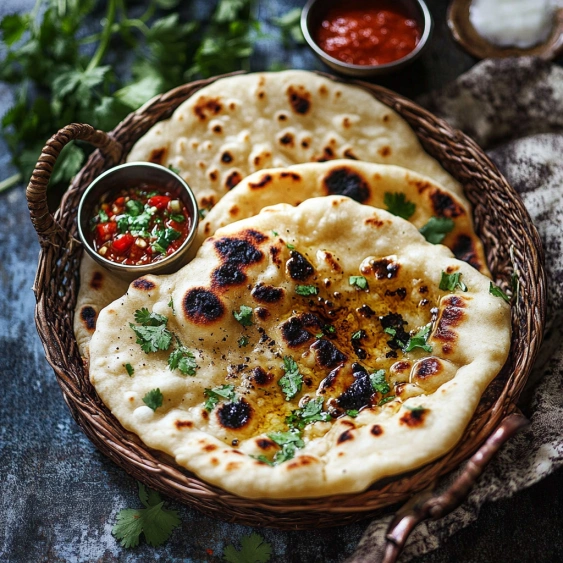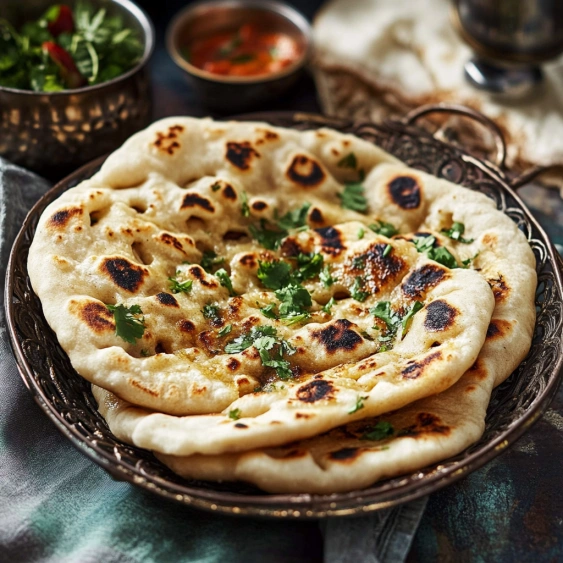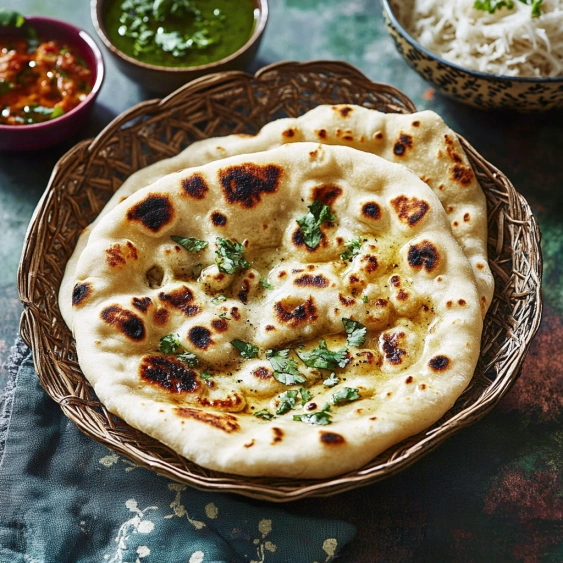 Pin it
Pin it
This homemade naan recipe transforms your kitchen into an authentic Indian bakery with pillowy, buttery flatbreads that rival your favorite restaurant's version. The slightly tangy, perfectly chewy texture comes from a simple yogurt-enriched dough that's surprisingly easy to master at home.
I discovered this recipe after years of disappointing store-bought versions and now my family gathers in the kitchen whenever they smell these cooking, eagerly waiting to tear into the first warm piece.
Ingredients
- Active dry yeast: activates the dough and creates that perfect bubbly texture
- Sugar: feeds the yeast and helps create that signature golden color
- All-purpose flour: works perfectly, no specialty flours needed
- Plain yogurt: adds tanginess and tenderness to the dough
- Salt: enhances flavor and strengthens the dough structure
- Oil: makes the dough pliable and easy to work with
- Melted butter or ghee: for that authentic richness and shine
- Fresh cilantro: optional but adds a bright finishing touch
Step-by-Step Instructions
- Activate Yeast:
- Combine sugar, warm water approximately 110°F, and yeast in a small bowl and stir gently. Let this mixture sit undisturbed for about 10 minutes until it becomes foamy and fragrant. This step ensures your yeast is alive and will properly leaven your naan.
- Prepare Dough Base:
- Transfer flour to a clean work surface and create a well in the center. Pour the activated yeast mixture into this well along with yogurt, salt, and oil. This method allows for gradual incorporation of wet ingredients into dry.
- Knead to Perfection:
- Work the ingredients together using your hands, folding and pressing for about 10 minutes until the dough becomes smooth, elastic and slightly tacky but not sticky. The kneading develops gluten which gives naan its distinctive chew.
- First Rise:
- Cover the dough with a damp kitchen towel and place in a warm, draft-free spot. Allow it to rise until doubled in size, approximately 60 minutes. This fermentation develops flavor and creates the airy texture.
- Portion and Shape:
- Divide the risen dough into 8 equal pieces by cutting with a bench scraper or knife. Roll each portion into a circle about 8 inches in diameter, keeping the thickness even throughout each piece.
- Cook with Care:
- Heat a cast iron skillet over high heat until very hot. Lightly oil the surface and place one rolled dough piece onto the hot skillet. Watch as it puffs dramatically and develops charred spots, then flip to cook the other side. Each naan takes only 1-2 minutes per side.
- Finish with Flavor:
- Brush each hot naan generously with melted butter or traditional ghee immediately after cooking. This adds richness and prevents the bread from drying out as it cools.
 Pin it
Pin it
The yogurt is my secret weapon in this recipe. I discovered after much experimentation that full fat Greek yogurt creates the perfect balance of tang and richness, though any plain yogurt works beautifully. My daughter now requests these naans for her birthday dinner every year instead of cake.
Storage Solutions
Freshly made naan stays soft at room temperature for about 6 hours when wrapped in a clean kitchen towel. For longer storage, cool completely then place in a ziplock bag with parchment between layers to prevent sticking. Refrigerate for up to 3 days or freeze for up to 2 months. To reheat frozen naan, sprinkle with a few drops of water and warm in a 350°F oven for 3-4 minutes until soft and warm throughout.
 Pin it
Pin it
Creative Variations
Transform this basic naan into garlic naan by mixing minced garlic into your melted butter before brushing. For cheese naan, sprinkle grated cheese on the dough before cooking the second side. Keema naan can be made by spreading seasoned ground meat on the dough before folding and cooking. The possibilities are endless once you master the basic technique.
Perfect Pairings
Naan traditionally accompanies Indian curries, but its versatility extends far beyond. Use it as a base for quick pizzas, fold it around sandwich fillings, or tear it into pieces for dipping in hummus or baba ganoush. My family particularly loves using leftover naan for breakfast, toasted and topped with scrambled eggs and herbs.
Historical Significance
Traditional naan dates back centuries in South Asian cuisine, originally cooked in clay tandoor ovens at extremely high temperatures. This home version adapts the technique for modern kitchens while honoring the bread's important cultural heritage. In many South Asian cultures, breaking bread together symbolizes hospitality and community, making naan not just delicious but meaningful.
Frequently Asked Questions
- → Can I make naan bread without yogurt?
While yogurt gives naan its traditional texture and slight tanginess, you can substitute with sour cream or buttermilk. For dairy-free versions, try coconut yogurt or a mixture of non-dairy milk with a teaspoon of lemon juice, though the flavor and texture may differ slightly from traditional naan.
- → Why is my naan not puffing up properly?
Several factors can prevent proper puffing: your skillet may not be hot enough (it should be very hot), the dough might be too thick or too thin, or the yeast might not have activated properly. Also ensure your dough had enough time to rise and double in size before cooking.
- → Can I freeze homemade naan bread?
Yes! Cool the naan completely, then stack with pieces of parchment paper between each piece to prevent sticking. Place in a freezer bag or airtight container and freeze for up to 3 months. Reheat from frozen in a 350°F oven or in a skillet.
- → What's the difference between using butter and ghee?
Both butter and ghee work well for brushing naan, but they offer slightly different flavors. Butter provides a familiar rich taste, while ghee (clarified butter) has a nuttier, more aromatic quality that's traditional in Indian cooking. Ghee also has a higher smoke point and is lactose-free.
- → What's the best pan for cooking naan?
A cast-iron skillet is ideal as it retains heat exceptionally well, creating those characteristic charred spots. However, any heavy-bottomed skillet or non-stick pan will work. Some people also use a pizza stone in the oven or cook naan directly on grill grates for extra char.
- → How can I add different flavors to my naan?
Naan is versatile! Add minced garlic and chopped herbs like cilantro or mint to the dough. For garlic naan, brush with garlic butter after cooking. You can also sprinkle with nigella seeds, sesame seeds, or stuff with fillings like spiced potatoes or paneer for stuffed naan varieties.
